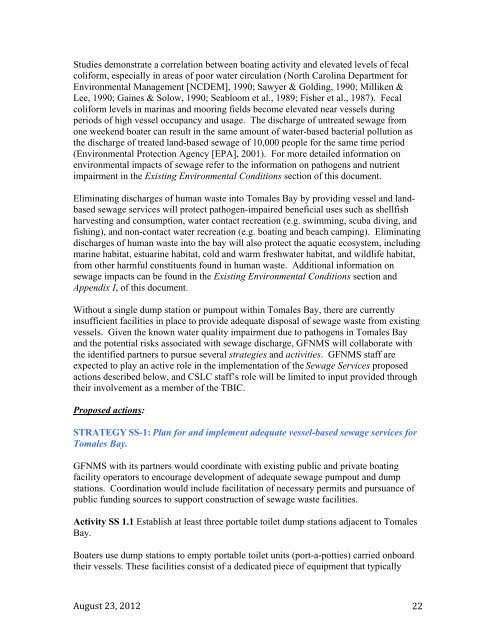draft tomales bay vessel management plan - Gulf of the Farallones ...
draft tomales bay vessel management plan - Gulf of the Farallones ...
draft tomales bay vessel management plan - Gulf of the Farallones ...
You also want an ePaper? Increase the reach of your titles
YUMPU automatically turns print PDFs into web optimized ePapers that Google loves.
Studies demonstrate a correlation between boating activity and elevated levels <strong>of</strong> fecal<br />
coliform, especially in areas <strong>of</strong> poor water circulation (North Carolina Department for<br />
Environmental Management [NCDEM], 1990; Sawyer & Golding, 1990; Milliken &<br />
Lee, 1990; Gaines & Solow, 1990; Seabloom et al., 1989; Fisher et al., 1987). Fecal<br />
coliform levels in marinas and mooring fields become elevated near <strong>vessel</strong>s during<br />
periods <strong>of</strong> high <strong>vessel</strong> occupancy and usage. The discharge <strong>of</strong> untreated sewage from<br />
one weekend boater can result in <strong>the</strong> same amount <strong>of</strong> water-based bacterial pollution as<br />
<strong>the</strong> discharge <strong>of</strong> treated land-based sewage <strong>of</strong> 10,000 people for <strong>the</strong> same time period<br />
(Environmental Protection Agency [EPA], 2001). For more detailed information on<br />
environmental impacts <strong>of</strong> sewage refer to <strong>the</strong> information on pathogens and nutrient<br />
impairment in <strong>the</strong> Existing Environmental Conditions section <strong>of</strong> this document.<br />
Eliminating discharges <strong>of</strong> human waste into Tomales Bay by providing <strong>vessel</strong> and landbased<br />
sewage services will protect pathogen-impaired beneficial uses such as shellfish<br />
harvesting and consumption, water contact recreation (e.g. swimming, scuba diving, and<br />
fishing), and non-contact water recreation (e.g. boating and beach camping). Eliminating<br />
discharges <strong>of</strong> human waste into <strong>the</strong> <strong>bay</strong> will also protect <strong>the</strong> aquatic ecosystem, including<br />
marine habitat, estuarine habitat, cold and warm freshwater habitat, and wildlife habitat,<br />
from o<strong>the</strong>r harmful constituents found in human waste. Additional information on<br />
sewage impacts can be found in <strong>the</strong> Existing Environmental Conditions section and<br />
Appendix I, <strong>of</strong> this document.<br />
Without a single dump station or pumpout within Tomales Bay, <strong>the</strong>re are currently<br />
insufficient facilities in place to provide adequate disposal <strong>of</strong> sewage waste from existing<br />
<strong>vessel</strong>s. Given <strong>the</strong> known water quality impairment due to pathogens in Tomales Bay<br />
and <strong>the</strong> potential risks associated with sewage discharge, GFNMS will collaborate with<br />
<strong>the</strong> identified partners to pursue several strategies and activities. GFNMS staff are<br />
expected to play an active role in <strong>the</strong> implementation <strong>of</strong> <strong>the</strong> Sewage Services proposed<br />
actions described below, and CSLC staff’s role will be limited to input provided through<br />
<strong>the</strong>ir involvement as a member <strong>of</strong> <strong>the</strong> TBIC.<br />
Proposed actions:<br />
STRATEGY SS-1: Plan for and implement adequate <strong>vessel</strong>-based sewage services for<br />
Tomales Bay.<br />
GFNMS with its partners would coordinate with existing public and private boating<br />
facility operators to encourage development <strong>of</strong> adequate sewage pumpout and dump<br />
stations. Coordination would include facilitation <strong>of</strong> necessary permits and pursuance <strong>of</strong><br />
public funding sources to support construction <strong>of</strong> sewage waste facilities.<br />
Activity SS 1.1 Establish at least three portable toilet dump stations adjacent to Tomales<br />
Bay.<br />
Boaters use dump stations to empty portable toilet units (port-a-potties) carried onboard<br />
<strong>the</strong>ir <strong>vessel</strong>s. These facilities consist <strong>of</strong> a dedicated piece <strong>of</strong> equipment that typically<br />
August 23, 2012 <br />
22







